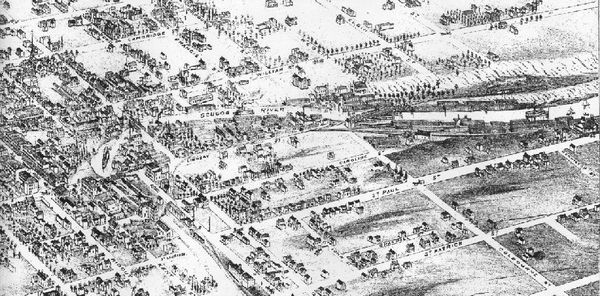Victoria Junction, Lindsay, Ont.
BACKGROUND
Before the Railway Age, travel and the movement of goods in Upper Canada were primarily dependent on waterways, and to some extent on such trails and crude strips of dust or quagmire that passed for roads. Both of these traditional modes of transportation relied very much on the seasons and the weather. Agitation for a more efficient mode of transportation had started to build with the news of the new-fangled railroad, but the economic depression of 1837 and the years following were bad years for Upper Canada and for railway development, especially in view of the unsettled economic and political conditions in England, on whose financial houses railway investment ventures depended.
However, in 1849 the Province of Canada passed the Railway Guarantee Act which guaranteed the interest on loans for the construction of railways not less than 75 miles in length. It was this legislation that triggered Canada's railway building boom.
THE JUNCTION (1875 - 1907)
For the years of its duration, Victoria Junction played a pivotal role in Victoria County railway history. The first railway to reach Lindsay was the Port Hope, Lindsay & Beaverton Railway (PHL&B). The first train arrived at the original Lindsay station at St. Paul and King Streets on the east side of the Scugog River on October 16, 1857. In 1871, this railway (by then the Midland Railway) was extended to Beaverton, reached Waubaushene in 1875 and arrived in Midland in 1879. It continued from its station beside the Scugog to cross it by means of a swing bridge, gained height along what is now the Rivermill condominium property and then curved west across what is now William Street at Orchard Park Road, and from there proceeded west across what is now the Lindsay airport. So far, no junction yet.

Bird's Eye View map, Lindsay, Ont. 1875, showing the original PHL&B entry and its facilities at Lindsay, and the later extension to Beaverton and beyond, across the Scugog River by means of a swing-bridge, which was abandoned in in 1883 and removed in 1887.
The first railway to reach "downtown" Lindsay was a struggling line that had begun as the Port Whitby & Port Perry Railway, reaching Port Perry in 1871. In 1876 it was extended to Lindsay, reaching Albert Street on June 15, 1877, becoming the Whitby, Port Perry & Lindsay Railway (WPP&L).
Enter George Laidlaw, a wheat merchant and railway promoter who had plans to tap the natural resources in the Haliburton Highlands. The project began modestly as the Fenelon Falls Railway in 1871. When this did not find financing favour, the railway broadened its scope with plans to extract timber and minerals from Haliburton County and what is now Algonquin Park, and in the next year it became the Lindsay, Fenelon Falls & Ottawa River Valley Railway.
To improve its promotional prospects, its name was changed in 1873 to the Victoria Railway. The first sod was turned in Lindsay (presumably in the vicinity of what became Victoria Junction) on August 5, 1874, by the Hon. C.F. Fraser, Commissioner of Public Works, in the presence of the Attorney-General of Ontario, the Hon. Oliver Mowat. Kinmount was reached after many vicissitudes in 1876, and the line reached and terminated for good at Haliburton in 1878.
At its Lindsay end, the Victoria Railway connected with the Midland Railway at the top of William Street North at "Victoria Junction" (also "Midland Junction"). Its track connected with the existing Midland line as a wye formation, permitting direct traffic both with Port Hope (through Lindsay along the Scugog) and Beaverton. Now there was a junction, and it remained very central to Lindsay's early railway operations for three decades of the booming Railway Age.
These are the three phases of Victoria Junction's development and change:

In 1875, the Victoria Railway connects up with the Midland Railway to get access to Beaverton, and more importantly, to Lindsay, sharing its King & St. Paul station.

In 1877, the Victoria Railway obtains the right to build a track right into downtown Lindsay to share a "union station" with the Whitby, Port Perry & Lindsay Railway. This configuration lasts until 1883.

In 1883, the Midland Railway reconfigures the routes through Lindsay and the swing-bridge across the Scugog is abandoned. The wye formation is now reconfigured to route eastbound traffic from the former Victoria Railway mainline. This lasts until 1907 when the successor Grand Trunk Railway builds a more direct line to Midland from downtown Lindsay.
Diagrams by Taylor Wilkins, author of Haliburton By Rail and the I.B.&O.
With the arrival of the Whitby, Port Perry & Lindsay Railway in Lindsay, the Victoria Railway applied to the Town of Lindsay for permission to connect its railway straight down Victoria Avenue to Glenelg Street to connect up with the WPP&L. This was approved on May 7, 1877

Victoria Junction - aerial photo 1957, courtesy Larry Murphy. All of the "leg" roadbeds are still clearly visible.

